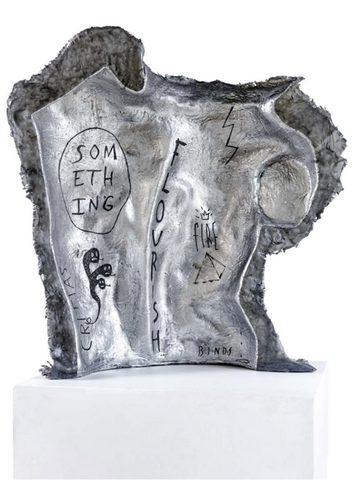THE WAY TO CRONUS
Memorial exhibition of Valentin Korzhov
02.09 - 17.10.2025
Winzavod Contemporary Art Center, entrance h8
On September 2, the a—s—t—r—a Gallery of Modern Art will host the opening of the Valentin Korzhov memorial exhibition "THE WAY TO CRONUS", dedicated to the fiftieth anniversary of the artist.
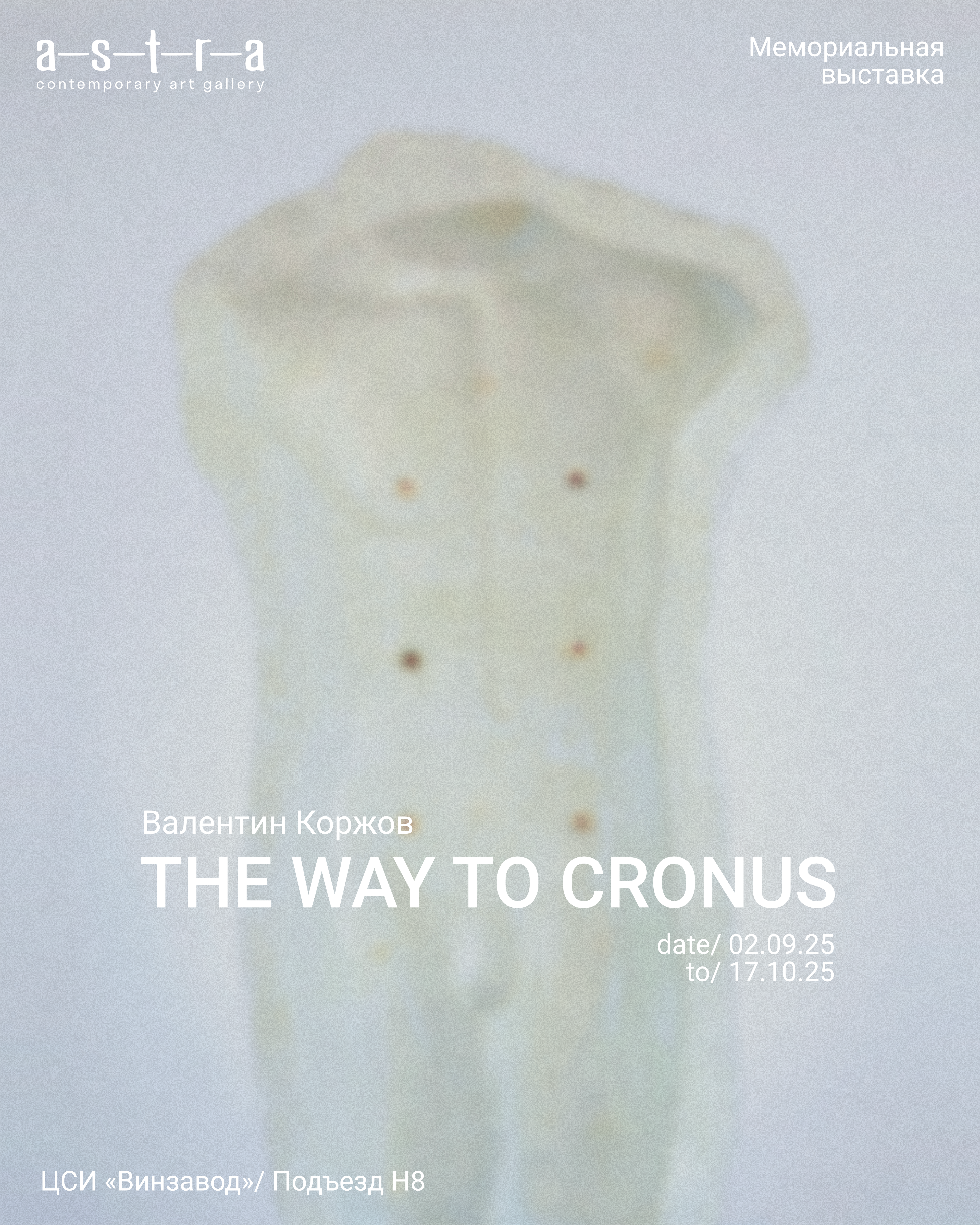
One of the most polyphonic contemporary Russian artists, who tragically passed away at the height of his career, worked with the entire medial spectrum of expressive means: from traditional to digital art and coding. He wanted to sound and sounded through projects in many registers at the same time. Moving too fast to care about strategies, in a rapid intuitive search, guided by the ideas and philosophical interlocutors of the past, Korzhov created different and seemingly distant works, but always united by a common goal - to touch the Source. And through them, I found and defined myself: "Reflection on the created work and thoughts around it become my reality." He argued, following Proust, that the work creates the author, that it is primary. His projects internally gravitated towards sculpture. Their thematic, genre, medial and plastic diversity implied a dense object form at the base, perhaps imaginary, or as a semantic center and assemblage point.
The exhibition "THE WAY TO CRONUS" by Valentin Korzhov at a—s—t—r—a galley places the artist's name in the field of public interest and topical art criticism, presenting his works from various projects as impeccable and indisputable examples of the rediscovery of artistic value.
Valentin Korzhov. A brief witness to Eternity
Text by Alexander Evangeli, curator, art critic, and contemporary art theorist
Valentin Korzhov built his own physics of the image. He seemed to be making works out of matter of a different nature: they tended towards emptiness, manipulating light as a plastic material, and time as potentially mirrored, but clearly in need of polishing. Method and meaning, rather than gloss, required sky-smooth surfaces, attention to reflections and phantoms, to polishing and electroplating. The work, reflecting the viewer and including him in itself, no longer existed for the gaze, but through it. The form generated the field of view and the optics of behavior. Exploring the action of thought in this field, Valentin Korzhov consistently built and programmed the optics of behavior. In the key series, it manifested itself in different states of aggregation.
The early sharp project "Darwin vs Darwin" was inhabited by hyperrealistic bodies — cold and a little posthumous, like anonymous anti-portraits from the assembly line of anthropotechnics. They smelled of anesthesia and the laboratory. They were made according to the rules of special effects and fake plastics, but the rigid neutrality of the human shell without a plot and psychology nullified genre plausibility. The gesture of the project, ethically uncomfortable and freezing, correlated the body not with a person or his image, but with an experimental site where a short circuit erased faith, instinct, violence and habit. Erasure was juxtaposed with theatrical and museum contexts: at the junction of set design and the naturalistic laboratory, Valentin Korzhov measured the rate of disintegration of humanistic signatures to the body — "personality", "soul", "dignity". It wasn't cynicism, but the cold honesty of the material.: what will remain if you remove the words? The answer is frighteningly clear. The recordings for the project recorded precisely these intentions, enhanced by the technology of FX realism.: The anthropomorphic doppelgangers impressed with their truthful literalness, only to expose its emptiness. As ideal performers, they staged plots from the Old Testament and art history — the empty patterns of post-history, that is, modernity, incapable of producing a productive universal utopia.
Valentin Korzhov radically changed the tone — from anatomy to cosmology — in the project "Being and Time". In deep space images from the Hubble telescope, he identified contours and trajectories in nebulae and clusters, transformed them into shapes and molded them into volume, then polishing them to the state of a mirror. In his early exhibitions, he placed objects in empty, snow-covered spaces in order to manifest forms taken from the cosmic void, against a background of "nothing." It was an exact reinvention of the Heideggerian scene, when "nothing" highlights being and reveals "form as form." He imagined bidirectional "channels between eternity and time," in which the infinite and the instantaneous passed into each other, so he was aware of his work. His explications and comments on projects sounded like ontological statements, but there was no doubt about the lively vibe of inspiration from philosophy, the intensity and aesthetic modes of interdisciplinary exchanges. These modes could be felt at the exhibition at the Ekaterina Foundation — low light, shiny surfaces, darkness as an active participant in the composition. It is important that the objects and their pure forms are not modernist abstractions and formalisms, but condensates of time, which explains the artist's insistence on a perfectionist pursuit of the reflective absolute, interest in white as a "zero color", electroplating and the electric luster of cosmic enamel, as if taken from NASA images.
But Valentin Korzhov also postponed his cosmology in covid 2020 for the sake of microphysics of growth in the Anizotropia project. Anisotropy, it is worth explaining, is a property of matter, the heterogeneity of its properties in different directions. Valentin built sculptures from bundles, multi-scale stresses, and growth nodes, which made them seem both fragile and inflexible. The constructive logic was also paradoxical: rigid rods formed soft trajectories, a metal skeleton behaved like living tissue and an anatomy without an organism. The artist moved from the great form to the conditions of shaping: he presented the algorithm itself. It's like being in a crystallography laboratory, where the law is not described, but put in place. There was a lot of talk about interdisciplinarity — everything is online. The gallery recorded the serial logic of "Anizotropia". The artist, curators, and critics discussed a combination of art, philosophy, and science, meaning as an emblematic example his online project, created by Korzhov in collaboration with technology partners, and physically made of concrete and stainless steel in Amsterdam.
He again took a step away from the Jungian deep layer promised by the name "Archetype" — he did not illustrate archetypes, but checked whether they could be turned into pure form operators. He worked with images of primordial figures - a conventional body, a seed, vision, gaping — but without mythological theater. Objects existed at the pre-narrative level as keys to locking and unlocking perception. This was the preconscious archetype before language, the ancient primary arche that shattered the sense of form. "Archetype" animated the very current of the image, removing the body from the story, whereas "Darwin vs Darwin" deprived the body of stories. In the comments, the artist returned to this initial layer — to the "primary intensity" of the look, which has not yet frozen into the plot.
In the Breakfast at Cronus project, time appeared as a predator. Kronos swallowed his children, but the artist changed the register of the myth: god's breakfast broke up into fragments and moments, into snacks of time — bright, sticky, plastic. In pop-baroque forms with traces of factory rubber, kitsch and sweet chemistry, "time-eater" unfolded the neat anatomy of consumption in front of us, reproducing our attention modes: we snack on time instead of living it. Explications and job descriptions complemented the project with another idea: time is capitalized, it can be cut into portions, packaged, and put into circulation. It was criticism without a slogan: the form did its job by itself.
In the Via Sacra project, the artist assigned a sacred trajectory, but not iconography or plot. He explored the ability of the material form to determine the modes of walking — attentive, enveloping, delaying; and explored the passage itself, the transition and the respectful distance between the viewer and the thing: not interactive, but a ritual removal from which the response of the form is clearly visible. He built a strict exposition economy: whiteness, contrast, and the discipline of light are the modern liturgy of a space sacralized by the ethics of visitation, but without religious doctrine. The media recorded the fact and the general outline of the project, and its exposure in a European context, which explained the shift in intonation — from the laboratory and cosmology to topology, to art as a practice of routes.
Valentin Korzhov methodically untangled the three knots of the modern image:
- The body node. In Darwin vs Darwin, he showed that the body is an infrastructure of beliefs and fears, not their hostage. When. This infrastructure is de—energized, and it's possible to watch without metaphors, and it's scary. This ruthless procedure brought the project closer to the critical realism of a wide range of special effects, from museum anatomy to the visualization of the posthuman in cinema.
- The shape node. In "Being and Time" and "Archetype", he demonstrated form as an event between nothing and a thing, rather than just a visible surface. Therefore, the logic of exposure was based on Heidegger: emptiness became an active tool for the manifestation of form. His texts, comments, and interviews on projects directly articulated this ontological setting.
- The growth node. In Anizotropia, form was first recognized as a function of the environment: not what has grown, but how it grows — that's how crystallographers see it. Therefore, it is not the motives that are important, but the connections and vectors. This reversal from iconography to the mechanics of what is depicted was a rare and precise gesture in modern Russian art.
Technology as a philosophy. Valentin Korzhov's technique never served the idea, it was the idea. The FX plasticity and hyperrealism in "Darwin vs Darwin" were not the aesthetics of shock, but the ethics of precision: when vision stops distinguishing "how it was done", the question "why was it done" arises. In "Being and Time", polishing and electroplating equalized time: the brilliance reflected the audience and the viewer, appropriated it and forced them to control the event. In Anizotropia, knitting and welding of steel elements built the physics of fragile equilibrium, assembling a diagram of forces before our eyes. In Breakfast at Cronus, mixed media winked at the advertising plastics and packaging industries: in this sculpture as display, exposure and production merged, as the form itself was an absorption of time.
Contexts. Valentin Korzhov moved along the borderline of the intersection of the Russian avant-garde with late ontology, where Rodchenko's pure forms and suprematist emptiness meet with a post-Heideggerian attention to "nothing" and a post-cosmic sensitivity to scale. In his texts and interviews, he spoke about his interest in the timeless, and meant not the aesthetics of space, but practical metaphysics. He lived in the media age and created online exhibitions with 3D visualization and built large screens into the park's infrastructure in urban installations. In all media, he behaved like an ascetic: he saved gestures, kept pauses, demanded eye discipline.
Why it is important. Modern art is overloaded with "positions" and "stories". Valentin Korzhov cut the narrative to the bone and left the viewer to practice watching, walking around, pausing, and tuning in to the resonances with the work. His works are modes of perception, not puzzles of messages. He invariably followed his own high standards of form and discipline — without pop psychology and spectacular tricks, and like the best modern artists, he was engaged in settings, not things. Somewhere it was radically cold, somewhere dangerously beautiful, but always extremely honest to their own foundations.
About the risk. It's easy to hide behind a philosophical dictionary. Valentin Korzhov did not do this. In his texts and public statements, he defended simple requirements: concentration, gaze, work of interest. Therefore, his sculptures did not become commentaries on philosophy — they themselves produced a philosophical situation. In the snow, in a dark hall, in the glare of mirrors, in the crunch of an anisotropic ligament, his form sought not explanations, but excerpts. A rare and difficult pleasure.
Коржов Валентин
1975 - 2022
Валентин Коржов - художник, ориентированный на идею пространства. Его воображение захватила идея пустоты Хайдеггера.
1975 — 2022
Член Московского Союза Художников, отдела скульптуры.
- 1998 — Окончил МПГУ, художественно-графический факультет
- 1996-2002 — Работал в творческой мастерской скульптура В.В. Сидоренко
- 2011 — Член секции скульптуры Московского союза художников и Объединения московских скульпторов
- 2018 — Входит в топ-100 русских художников, по версии «InArt»
- 2020 — Финалист XIV Международной премии «Arte Laguna»
Скульптурную практику Валентина Коржова можно охарактеризовать как абсолютную пространственность, устремленную к динамической эстетике пространства. Под влиянием феноменологии Хайдеггера и его необычной концепции ничтожности как фундаментальной основы существования, Коржов помещал свои скульптурные интервенции - загадочные нарративы о материи и самости - в онтологическую точку ноль, в пустоты. Через противопоставление зловещих скульптурных композиций и физических пустот бесплодных полей и пустых поверхностей возникает третье пространство неограниченной пространственности.
Коржов родился в Москве, получил образование по скульптуре в художественной академии и начал свою профессиональную карьеру в мастерской скульптора-мастера Виктора Сидоренко. В его работах неоклассические изображения тела сливаются с постмодернистскими идеями о материальности, происхождении и реликвиях, создавая объекты, которые одновременно и присутствуют, и являются симулякрами археологических обломков из неопределенных, отдаленных времен, будь то в прошлом или будущем. В многодисциплинарных инсталляциях, которые манипулируют пространственностью как медиумом, художник занимался созданием иммерсивных опытов, черпающих вдохновение не только из ресурсов искусства, но и из современной философии и науки.
Темпоральность в работах Коржова смещена; он читает палимпсест цивилизации как сложный гобелен из переплетенных текстов, образов и архетипов, уходя от историцизма скульптуры к изначальному мифографическому пространству, которое охватывает и отдаленное будущее. В его пространственных конструкциях различные темпоральности сливаются, открывая новые пути для интерпретации истории образов через текст, теорию, визуальную культуру и сенсорное восприятие. Как практик, основанный на исследованиях, художник был постоянно вовлечен в диалоги с мыслителями прошлого и настоящего, уникальным образом пересказывая дискурс современной культуры.
В практике художника сложно выделить одно направление - каждая из его работ является сочетанием скульптуры и художественной композиции, расставленной с театральной точностью и запечатлённой на фотообъектив. Коржов превращает каждый свой проект в масштабную коллаборацию с участием признанных международных фотографов, кинорежиссёров, актёров и профессиональных техников. Конечный результат для зрителя являет собой многоплановые инсталляции с эффектом глубокого погружения, с сочетанием кульптуры, видео и фотоискусства.
Валентин Коржов был членом секции скульптуры Московского союза художников, его персональные выставки проходили в Фонде культуры «Екатерина», Государственном Музее им. Дарвина, Центре Современного Искусства «Винзавод», Воронежской Академии Искусств и других. Экспозиция «Археология Памяти» демонстрировалась в качестве параллельной программы в ходе V Международного Московского Биеннале Современного Искусства. В 2018 году проект «BEING & TIME» вошел в состав основных проектов VIII Ташкентской Международной Биеннале современного искусства, а в 2020 году Валентин стал финалистом XIV Международной Премии Arte Laguna и в марте представил свою инсталляцию «THE BRAIN THAT PASSED AWAY» в Венеции.
Коржов жил и работал в Москве. Трагически погиб в 2022 году в результате автомобильной аварии.
О ПРОЕКТЕ «DARVIN VS DARVIN»:
Проект «Darwin vs Darwin» – оригинальная попытка синхронизировать законы биологического и духовного развития человека. Фантастический мультимедийный проект Валентина не просто сталкивает между собой начало и финал эволюции всего живого, но и заставляет прожить эту драму как мгновенную эволюцию сознания, зрения, самого искусства. В рамках проекта были созданы гиперреалистичные анималистические и человекоподобные скульптурные объекты из силикона, выполненных в FX технике, что производит впечатление абсолютной достоверности происходящего, а также произведения фото- и видеоискусства.
О ПРОЕКТЕ «BREAKFAST AT CRONUS»:
Проект «Breakfast at Cronus», сосредоточенный на основополагающих нарративах Древней Греции, рассматривает античный миф о Кроносе – прародителе времени – и ряде других архетипических персонажах, чтобы раскрыть расширенную основу реальности; видимость, заключённую в чистой действительности. Коржов отталкивается от хайдеггеровского понятия поэзиса – акта создания или творения, тождественного метафизике и поэзии, а также непосредственной данности материального мира, готового к преобразованию нами. Это открытие ведет к истине или сущности, лежащей в основе нашего технологического воображения и помогающей чему-то возникнуть.
О ПРОЕКТЕ «VIA SACRA» и «THUS SPOKE HEAVEN»:
Если в ранних его проектах подчеркивается животное начало человеческой сущности (Darwin vs Darwin), то со временем в работах все больше отражается начало духовное. Валентин очень долго искал, нащупывал путь, позволяющий изобразить чувства, эмоции, тонкие, неосязаемые в скульптуре материи и при этом уйти от прямого цитирования. И если в первых проектах для художника характерна прямолинейность высказываний, то в последних работах он пришел к компромиссу иносказательности и фигуративности. Он берет слепки с греческих статуй как форму для отлива скульптуры и использует эту форму как ячейку, ракушку — она символизирует наше тело. Это сосуд для нематериального содержимого — того, что ведет нас к сверхчеловеку (по Ницше), — души.
О ПРОЕКТЕ «BEING AND TIME»:
Проект «Бытие и Время» представлял варианты земного воплощения геометрии космических тел. В качестве прототипа для своих произведений Валентин использует фотоснимки скоплений галактик, туманностей и астероидных поясов. Для моделирования объектов художником был разработан специальный метод соединения точек источников света на фотографиях космоса. Работы словно «космические слепки», в которых едва можно угадать рукотворность, повествуют зрителю о формах бытования в Галактике. Коржов материализует в объектах космические пустоты. Манифестируя первичность «идеального закона» бытия над временем, он даёт предметное представление о связи цивилизации с космосом. Творчество художника апеллирует к архаическим знаниям о Вселенной. Тогда представление об «объёме жизни» зависело от воображения. Такой подход может быть актуален и в наши дни как опыт познания бытия и времени.
О ПРОЕКТЕ «ANIZOTROPIA»:
Проект ANIZOTROPIA, состоящий из скульптур и объектов, исследует тему пространства и формы в контексте небытия как наследие метафизики формы Хайдеггера. Само название проекта связано с представлением древних греков об уникальной, невидимой и непредсказуемой траектории роста различных объектов в природе. Этот термин широко используется в физике твердого тела, химии и кристаллографии для определения зависимости характеристик объекта от его анизотропного состояния. Если сказать проще: материал считается изотропным, когда его свойства во всех направлениях одинаковые. Если же с изменением направления свойства материала изменяются, материал считается анизотропным. Точно так же скульптура из металлических труб и предметов повседневного обихода в процессе творчества принимает внутреннюю непредсказуемую форму, а конечный результат неизвестен до последнего момента. Следуя внутренней естественной логике художника, реди-мейды, использованные в инсталляциях, теряют свою четкость и функциональность, превращаясь в чистую форму.
ИЗБРАННЫЕ ВЫСТАВКИ И ПРОЕКТЫ:
- 2025 — Ярмарка |catalog| декабрь, a—s—t—r—a галерея, Москва, Россия
- 2025 — Cosmoscow, a—s—t—r—a gallery, Москва, Россия
- 2025 — The way to Cronus, галерея a—s—t—r—a, Москва
- 2023 — Darwin vs Darwin. Zimova Art Buro, Москва
- 2022 — Breakfast at Cronus. Nadya Kotova Gallery, Антверпен, Бельгия
- 2021 — Observer of Immense Space. Public Art. Зарядье, Москва
- 2020 — Anizotropia. Центр искусств «Artcatch», Нидерланды
- 2020 — Round around. Галерея Gridchinhall, Cube Moscow, Москва
- 2020 — ROUND AROUND Совместно с Олегом Хвостовым, Gridchinhall Moscow, Арт-центр Cube, Москва.
- 2019 — Being and Time. Asia Contemporary Art Show, Gallery Bruno Massa. Гонконг.
- 2019 — Being and Time. Bahrain International Exhibition and Convention Center. Манама, Бахрейн.
- 2019 — Across Borders, Бахрейн
- 2019 — Being and Time, культурный фонд «Екатерина», Москва
- 2018 — Международная Биеннале Современного Искусства, Ташкент
- 2018 — Последний Иов, Фонд Михаила Шемякина, Санкт-Петербург
- 2018 — Flesh And Sky, Галерея 11.12, куратор Аттилия Фаттори Франкини, «Винзавод», Москва
- 2017 — Уроки Естественной Истории, Государственный Музей им. Дарвина, Москва
- 2017 — «Актуальная Россия: игра в классиков», совместно с Государственным центром современного искусства. Саратовский государственный художественный музей имени А.Н. Радищева
- 2016 — «Актуальная Россия: среда обитания», Государственный музей современной истории России, Москва
- 2014 — Белый Курган, Академия Искусств, Воронеж
- 2013 — «Археология памяти», Параллельная программа V Московской биеннале современного искусства, куратор Владимир Потапов. «Гоголь-Центр», Москва.
- 2013 — Проект V Московской Биеннале Современного Искусства, Москва
- 2012 — Zeta-потоп, Гоголь-центр, Москва
- 2009 — Серые Экраны, Центральный Дом Художника, Москва
Works
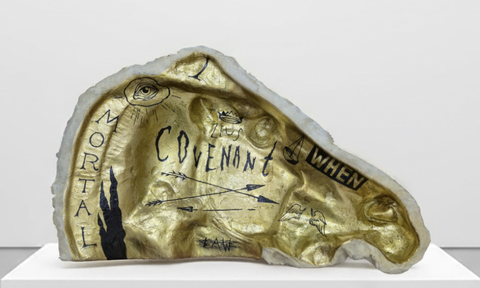
Korzhov Valentin
Untitled #7 из проекта Thus Spoke Heaven, 2020
Стекловолокно, сусальное золото
60 х 110 х 35 см
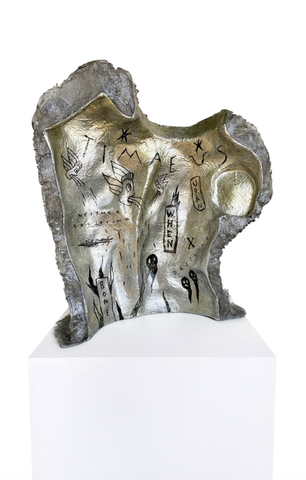
Korzhov Valentin
Timaeus из проекта Thus Spoke Heaven, 2021
Стекловолокно, сусальное серебро
71 х 65 х 28 см
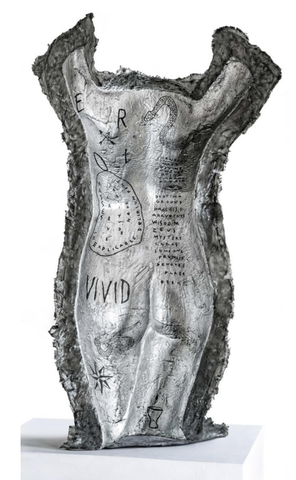
Korzhov Valentin
Untitled #2 из проекта Thus Spoke Heaven, 2021
Стекловолокно, сусальное серебро
110 х 45 х 75 см
